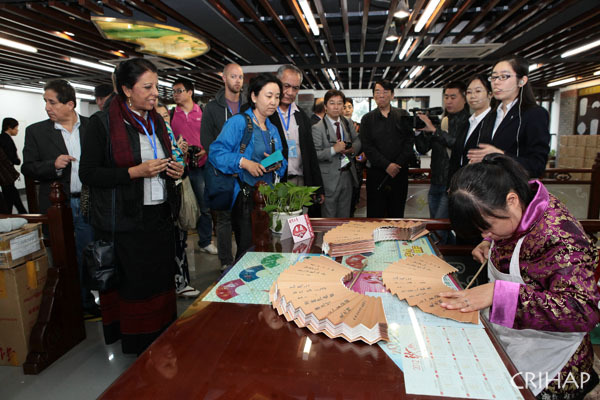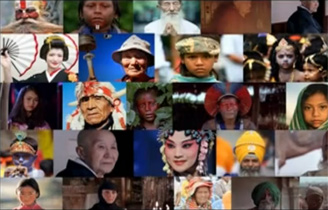Workshop on safeguarding and sustainable development of traditional craftsmanship in the Asia-Pacific region

Full view of the meeting place
Traditional craftsmanship, an integral part of intangible cultural heritage, holds particular spiritual value, way of thinking and imagination in every country and nation. It embodies the cultural tradition, life experience and aesthetic taste of a nation, as well as demonstrates the vitality and creativity of it. It is the brainchild of the masses in every country and nation.
From Oct 17 -20, 2013, a workshop on the safeguarding and sustainable development of traditional craftsmanship in the Asia-Pacific region was held in Hangzhou, China. Over 30 people from UNESCO regional offices and regional centers of the lists of UNESCO intangible cultural heritage and 17 Asia-Pacific countries such as Japan, Myanmar and Nepal and countries in other regions attended the workshop. They are experts engaged in the research and preservation of traditional craftsmanship, master traditional craftsmen or heads of related institutions. A dozen workers protecting intangible cultural heritage in China also attended the meeting as observers.
Prior to the workshop, representatives were invited to attend the Pacific-Asia Traditional Craftsmanship Fair held in Hangzhou. They observed and studied the inheritance program and achievements in the protection of traditional craftsmanship of every country. They also learned more about the cultural connotations and value of traditional craftsmanship to further improve the scientific protection and inheritance of traditional craftsmanship and jointly explored methods for sustainable development.

Group photo
Basic Information
The main content of the workshop included the keynote speech, lecture and cultural inspection. Chinese and English were the working languages.
Topic
1. The advantage of traditional craftsmanship in ecological civilization construction
2. The protection and inheritance of traditional craftsmanship
3. The innovation and sustainable development of traditional craftsmanship
Representatives:
|
Nationality |
Name |
Institution and Position |
|
China |
Wu Yingwen |
Representative inheritor of the Intangible Cultural Heritage Program “crystal carving” |
|
Wen Qiangang |
Representative inheritor of the Intangible Cultural Heritage Program “lacquer engraving” | |
|
Wang Shuwen |
| |
|
Gao Gongbo |
| |
|
Zhou Jinyun |
Representative inheritor successor of the Intangible Cultural Heritage Program “ou su (color emboss)” | |
|
Sun Jianjun |
Researcher of the National Arts Academy of China | |
|
Qiu Chunlin |
Researcher and deputy head of the Arts and Crafts Institute of National Arts Academy of China | |
|
Shang Gang |
Professor at the Academy of Arts and Design of Tsinghua University; director of Academic Committee | |
|
The Philippines |
Ricardo FAVIS |
Bangkok office of the UNESCO; cultural program expert |
|
Bernadette DAVID |
Art officer and curator of the Philippines culture and art national committee | |
|
Peru |
Fernando VILLAFUERTE
|
Director of the Intangible Cultural Heritage Protection Center in Latin America |
|
Indonesia |
Gaura MANCACARITADIPURA |
Advisor to the deputy head of the Ministry of Education and Culture in Indonesia |
|
India |
Ritu SETHI |
chairman of the Indian National Craftsmanship Renaissance Foundation |
|
The USA |
Linda LOMAHAFTEWA |
Assistant Professor,Institute of American Indian Arts |
|
Nepal |
Rajesh Kazi SHERSTHA |
President |
|
Myanmar |
Khin Maung HTWE |
HTWE OO MYANMAR Puppetry Home |
|
Tonga |
Penisimani FIFITA |
Chief program officer of the ministry of Culture of Tonga |
| Afganistan | Rangina HAMIDI |
Cultural Activity
Wangxinji Fan

Trainees watch how a Wangxinji Fan is made.
Wangxingji Fan Mill boasts a 126 year history. In further developing and strengthening the undertaking, the mill has constructed a colorful kingdom of fans using traditional techniques, rich variety and a quality brand. It is the only antique fan mill still existing in China.

Trainees watch how a Wangxinji Fan is made.
There are more than 400 varieties of products in 15 categories. For example, the black-paper fan has won fame as "a fan like half of an umbrella". The fine silk fan is of delicate beauty. The hanging fan is extraordinarily dignified and impressive in appearance. The silk dancing fan is graceful. The sandalwood fan is inexpensive but elegant. The fans made by Wangxingji are called "the treasure of Oriental art" by overseas friends.
Address: 81, Laiguangying West Road, Chaoyang District, Beijing, China
Zip Code: 100021
Tel: 86-10-64966526
Fax: 86-10-64969281
E-mail: administration@crihap.cn
NEWSLETTER
Leave us your e-mail address, we'll let you know about current events.



